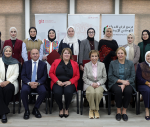You are here
Refugees create demographic, economic, environmental, security challenges for Jordan — HPC
By JT - Dec 17,2023 - Last updated at Dec 17,2023

An aerial view of the Zaatari camp for Syrian refugees in northern Jordan (JT file photo)
AMMAN — Jordan is facing a challenge in dealing with migration due to the involvement of several entities dealing with the issue, which hinders the formulation of effective policies for international migration management, the Higher Population Council (HPC) said on Sunday.
In a statement marking the International Migrants' Day, which falls on 18 December, HPC stressed the need for a collaborative partnership between all relevant bodies dealing with migration, calling for the establishment of a dedicated entity responsible for the comprehensive management and governance of migration.
"This unit would facilitate coordination between the various ministries and institutions dealing with migration issues," the statement said.
By the end of 2023, Jordan's population is estimated at 11.5 million, of which at least one third are not Jordanians, the council said. "Over the past 19 years, the population has increased by 6 million with official data showing that the percentage of non-Jordanians living in the Kingdom has increased from 4.2 per cent of the total population in 1979 to 7.7 per cent in 2004 and to 30.6 per cent in 2015."
The council said that refugees have created demographic, social, economic, environmental and security challenges for Jordan, besides increasing pressure on the Kingdom's "limited" resources of water, public services, housing, economic growth, trade, exports, tourism and investment. "The influx has also strained education and health services, particularly hospitals and health centres in rural areas hosting Syrian refugees."
"The influx of Syrians into the Jordanian labour market has changed the economic dynamics in a complex way, creating new challenges for Jordanians seeking employment."
The council said that in 2022, the number of registered non-Jordanian workers, documented through work permits issued by the Ministry of Labour, reached approximately 352,000, with Egyptians dominating this workforce.
Jordan remains committed to upholding the rights of migrants and has enacted legislation to protect their interests, the council said.
Citing figures from the National Population Strategy for 2021-2030, a joint effort between the HPC and the United Nations Population Fund, the council said that Jordan is currently experiencing an annual migration rate of 4.1 per cent, while lifetime migration stands at 11 per cent.
A survey conducted in 2014 shed light on migration motives, revealing that 63 per cent of Jordanian migrants left for economic reasons, while 26 per cent left in search of better employment opportunities, it said.
"By the end of 2021, the Foreign Ministry reported that the number of Jordanian migrants reached 925,000. The ministry's data also revealed that 81.7 per cent of Jordanian expats are residing in Gulf countries, followed by 15.2 per cent in non-Arab countries and 3.1 per cent in other Arab countries."
Underlining the social and economic impact of Jordanian migrants working abroad and their financial remittances, the council highlighted the significant increase in remittances, which jumped from JD9.1 million in 1965 to an estimated JD2.203 billion in 2022.
Related Articles
AMMAN — Jordan houses more than 57 nationalities, Secretary General of the Higher Population Council (HPC) Abla Amawi said on Thursday on th
AMMAN — The percentage of non-Jordanians residing in the Kingdom went up from 4.2 per cent of the total population in 1979 to 7.6 per cent i
The sudden increase in the number of non-Jordanians in the Kingdom has affected population growth and fertility rates, and led to an increase in crime, an official said this week.















